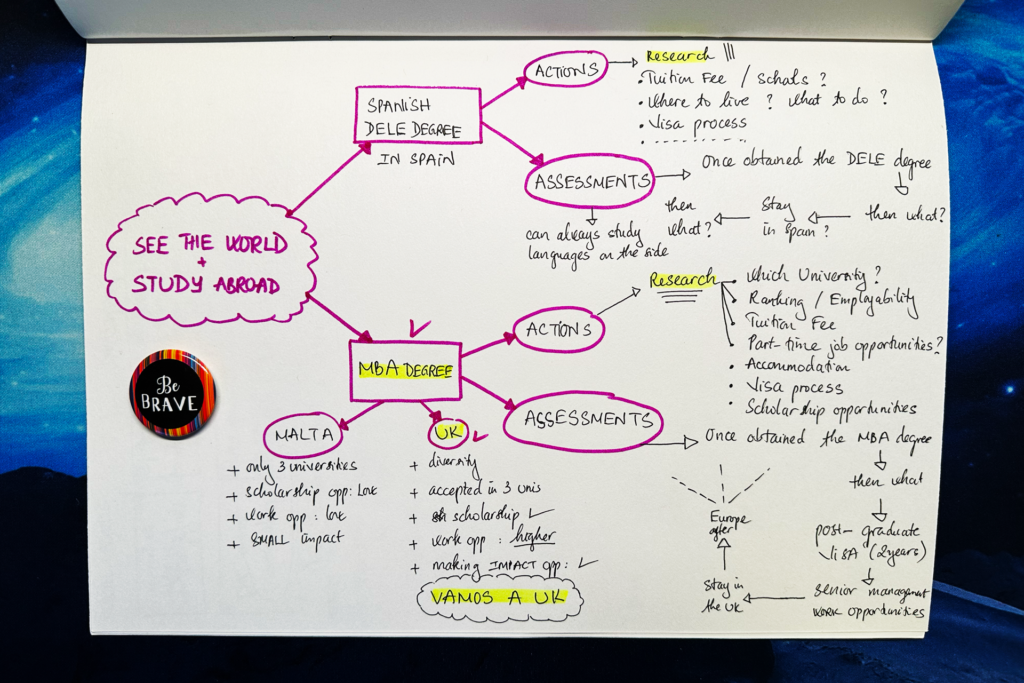If you have a dream and believe in it, you can make it a reality with a strategic approach.
In this blog post, I will share my step-by-step method for determining my life’s direction using the Decision Tree road map and implementing it One Step At A Time.
What is a decision tree? I was unaware of the term until I came across it during my further reading for the Corporate and Competitive Strategy Module. However, I soon realised that I had been using this method to make decisions without knowing it.
Whether you are a business strategist, a medical professional, or someone seeking personal growth, this framework can guide you in making choices that align with your goals and values.
Please keep in mind that the Decision Tree differs from person to person and how you use it for a specific problem. The ultimate goal is to find the best solution for you possible.
Understanding the Decision Tree
Before delving into the practical application of the Decision Tree framework, let’s briefly explain what it entails. A Decision Tree is a diagram that presents possible solutions to a decision based on certain conditions. It’s called a “tree” because, much like a tree, it starts with a single box (or root) and branches off into various solutions. This framework has been used for decades in multiple fields, including business strategy, medical diagnosis, and machine learning.
The original finding of this framework was from the book Thinking Strategically (The Competitive Edge in Business, Politics, and Everyday Life) by Dixit and Nalebuff. They use the Decision Trees and Game Trees to explain different strategic approaches in Game Theory. If you want to further your understanding of this book, I invite you to do your research. Now, I want to ensure you have enough business and academic terms; hence, I simplify it and compare it to real-life scenarios to help you make choices in daily life easier and smoother, more critically and logically.
Using the Decision Tree Road Map to Pursue Dreams
Now, let’s explore how the Decision Tree road map can be applied to turn dreams into reality. To illustrate this, I will share a personal example of using the Decision Tree, combining this technique with Reverse Engineering, and starting the process with my ultimate goal, or in other words, my Dream Goal: To study abroad.

Let me give you some background. Since my teenage years, I’ve had a burning desire to see the world by pursuing higher education outside Vietnam. I’ve always dreamt of becoming an international citizen. In 2013, I attempted to realise this dream but failed miserably, not once but twice. However, those setbacks didn’t dampen my belief that I could make it happen one day. A decade later, when a significant event changed my life, I knew it was time to decide what to do next. That’s when my hidden dream resurfaced, and I felt an urgency to act.
Goals or Dreams Clarification
My goal was crystal clear: I wanted to explore the world and educate myself. But what was the right approach for me? How could I ensure success this time in realising my dream?
Two alternatives came to mind: studying the language in Spain to become a translator or pursuing an MBA in Malta or the UK. I gathered information to determine which path made the most sense and aligned with my long-term goals and values. In addition, I thoroughly assessed the possibilities ahead, considering the outcomes of earning either a Spanish translation degree or an MBA degree.
Step 1: Collect relevant information
Our inability to make decisions is often rooted in a lack of information. Hence, the first crucial step is to gather as much information as possible.
In my case, I reached out to over ten language schools in Spain that offered the DELE course. Furthermore, I inquired about tuition fees and visa support. Additionally, I consulted friends about the best cities in Spain, researched the cost of living, and explored potential working opportunities. This extensive process took over two months.
For the MBA option, I attended a Study Abroad Fair hosted by ISC Education, spoke to university representatives to learn about programs and tuition fees, and delved into post-graduate opportunities. At the same time, I researched over ten universities, seeking information about scholarships and other relevant aspects. I also dove into the specifics of the MBA programs at different universities, understanding the course structure, subjects offered, and duration. I attended webinars and online information sessions hosted by the universities to gain more insights.
Furthermore, factors such as the city of each university, the cost of living, lifestyle, and post-graduation job opportunities were all integrated into my analysis. I considered university rankings and how potential employers perceive different MBA programs. Finally, I compared tuition fees, researched scholarships, and estimated living expenses in various cities.
Step 2: Assess the gathered information
One valuable lesson I’ve learned is determining when you’ve gathered “enough” information.
Taking too long in the previous step can lead to procrastination. On the other hand, gathering sufficient information can result in clarity and potentially starting from scratch.
Once I had enough information, I thoroughly assessed it. In this stage, seeking peer reviews or advice from someone knowledgeable or experienced in the field can prove very beneficial. It’s vital to ensure that the person you seek advice from genuinely wants the best outcome for you.
Upon reflection, I realised pursuing an MBA aligned with my long-term goal of becoming an international businesswoman. With my existing BA (Bachelor in Business Administration) and HND 3D Design degrees, an MBA (Master Business Administration) holds more weight for my career advancement than a Spanish translator degree. An MBA represents a step up in my field of business and management, while a Spanish translator degree would be more of a lateral move.
In strategic terms, a Spanish degree would offer diversification by expanding my skills and industry. In contrast, an MBA represents vertical integration by delving deeper into a field I am already passionate about and knowledgeable in. It is time for me to invest more deeply in my business knowledge in an international environment.
Step 3: Decision Making
Before making a decision, it’s crucial to take inventory of your resources and capabilities. When assessing my options, I applied the “Resources and Capabilities” concept from business for personal analysis. Put simply, Resources are what you have (tangible or intangible), and Capabilities are how you use them. In other words, it involves analysing your strengths and weaknesses. This involves evaluating your knowledge, skills, time, and financial resources. It’s about understanding what you have and what you can do.
For example, when deciding whether to pursue further studies or start a business, I had to consider my resources and capabilities. I looked at my financial situation, time availability, skill set, and current knowledge base.
In terms of capabilities, I had a solid academic background, which would be advantageous for further studies. However, I also had some entrepreneurial experience from a small venture I had run during my undergraduate years, which could be beneficial if I started a business in a new country.
As a result, I made a more informed decision by evaluating my resources and capabilities. The critical factor for me was the scholarship offered by Brunel Business School, which helped me finalise and commit to my decision on the MBA journey. I have been in the UK for five months, and it has been the best decision ever. If you want to learn more about my studying abroad in the UK, I invite you to explore it here.
Step 4: Stick to Your Decision
Once you’ve decided, committing to it and staying focused on seeing it through is crucial. It’s natural to have moments of doubt or consider alternative paths when faced with challenges. However, constantly wavering can lead to a lack of progress and missed opportunities.
Remind yourself that by choosing one path, you consciously choose to forego others, and that’s perfectly okay. It’s better to fully commit to one direction and give it your all rather than spreading yourself too thin by trying to pursue multiple paths simultaneously.
So, what dreams have you been putting off? What decisions do you need to make? Take the time to map out your options and see the bigger picture. With a strategic approach, you can make a decision that aligns with your goals. Once you have made your decision, stay committed to it. You may need to adjust along the way, but remember that the ultimate goal is reaching your desired destination. And remember to enjoy the journey because it is the journey that makes all the effort worthwhile, not just the destination.
I’ll leave you with my favourite quote, a daily reminder from my Strategy Module’s leader, who has inspired me to become a Business Strategist, Oksana Gerwe:
“You cannot be everything to everyone. If you decide to go north, you cannot go south at the same time” – Jeroen De Flander.


